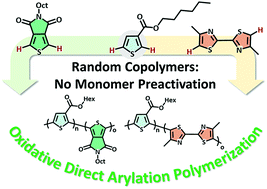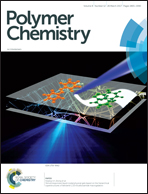Synthesis of random poly(hexyl thiophene-3-carboxylate) copolymers via oxidative direct arylation polymerization (oxi-DArP)†
Abstract
Oxidative direct arylation polymerization has recently emerged as a simple, mild, and atom economical homopolymerization method; however, the application of this promising method to unsymmetrical or binary monomer systems, where different C–H reactivities are present, is limited. Two random copolymer families of poly(hexyl thiophene-3-carboxylate), herein referred to as poly(3-hexylesterthiophene) (P3HET), featuring either thieno[3,4-c]pyrrole-4,6-dione (TPD) or 4,4′-dimethyl-2,2′-bithiazole (BTz) comonomers are synthesized by oxidative direct arylation polymerization (oxi-DArP) conditions that enable high regioregularities despite the lack of preactivation of the monomers. Through refinement of the reaction parameters and minimization of auxiliary reagent loadings, polymers with good molecular weights are achieved and the feed ratio is closely correlated to the polymer composition. These random copolymers are evaluated by 1H NMR, SEC, UV-Vis, GIXRD, and SCLC hole mobility analyses to determine the compatibility of this emerging synthetic method with increasingly popular random copolymer architectures.



 Please wait while we load your content...
Please wait while we load your content...